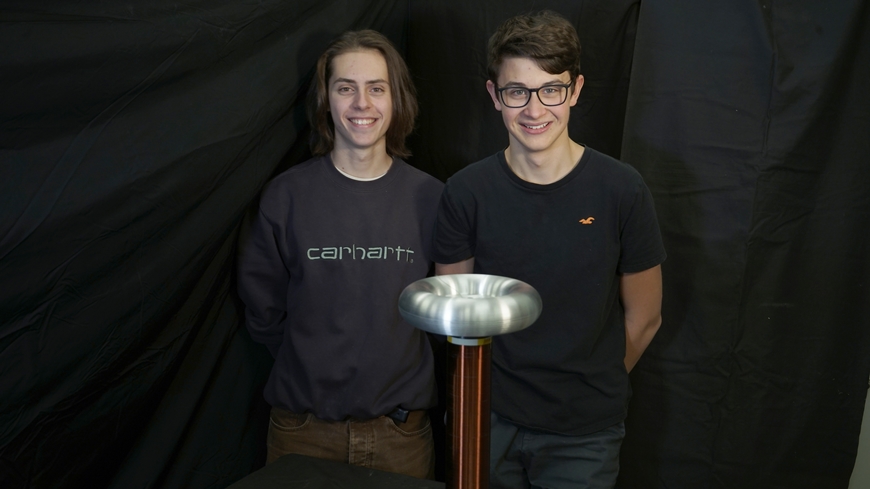Monitoring greenhouse gas emissions
Fighting climate change with satellite data and AI
A new study by the Swiss Academy of Engineering Sciences (SATW) shows how artificial intelligence (AI) can be used to reduce the impact of climate change on Switzerland. The experts involved have high hopes for satellite-based earth observations and AI models. According to Empa researcher Gerrit Kuhlmann, one of the co-authors of the study, these could quickly identify the sources of greenhouse gas emissions.

The Paris Agreement requires participating countries to report their greenhouse gas emissions in order to determine global progress towards the net zero target. Currently, however, emissions reporting is mainly based on emissions inventories calculated from socio-economic statistics on activities and emission factors. What's more, compiling the data proves to be resource-intensive, time-consuming and associated with many uncertainties – and thus insufficient to evaluate political measures in a timely manner. Empa researcher Gerrit Kuhlmann therefore explains in a case study in the new SATW white paper how AI combined with new earth observation data and earth system models could be used to efficiently monitor greenhouse gas emissions. The aim of the SATW study was to show how new technologies can reduce the negative effects of climate change in Switzerland and make society and the economy more resilient.
Tracking major emitters faster
A global system for measuring greenhouse gas emissions will be an important tool for monitoring progress towards a net zero society. Therefore, monitoring systems are currently being developed that can provide accurate, reliable and global real-time information on anthropogenic greenhouse gas emissions. These systems use airborne, satellite and ground-based measurements. Models analyze the data and calculate emissions from countries as well as from individual power plants and industrial facilities. "AI plays an important role for global systems, as it makes it possible to process large amounts of data quickly and accurately," says Empa researcher Kuhlmann. "AI-supported algorithms can be used to create global maps of CO2 and methane emissions. This can be used, for example, to identify emission hotspots or better estimate the carbon footprint of products." In future, this data could be used to quickly identify major polluters and determine their greenhouse gas emissions.
Access to international research programs is crucial
The experts involved in the SATW study have high hopes for the latest developments in AI and satellite-based earth observations in order to master the climate challenges. To ensure that the potential of AI can be fully exploited, the authors of the study have also formulated recommendations for decision-makers in politics and administration, universities and funding institutions as well as companies. For example, the AI capabilities and expertise of national competence centers in the field of climate and sustainability should be strengthened and access to international research programs such as those of the EU should be ensured.
According to Kuhlmann, the development of models for a global monitoring system for greenhouse gases requires access to global earth observation data. "Access to the services of the European Copernicus program is crucial for Switzerland in order to be able to continue research in this area." This is because the EU's Earth observation program is a leader in greenhouse gas observation systems – especially with the upcoming expansion of Earth observation satellites with satellites for CO2 and methane measurement as well as the European CO2 monitoring and verification system. These developments are being driven forward in particular within the framework of international research programs such as Horizon Europe, which is why full participation is of central importance for Swiss researchers.
SATW study on AI and climate change
Climate change is having a negative impact worldwide – and Switzerland is particularly affected. More than 70 experts and researchers from 30 renowned Swiss universities, authorities and industrial companies wanted to find out how new key technologies and methods can make our society and economy more resilient. The result is a comprehensive study (white paper) and a summary (factsheet). Empa researcher Gerrit Kuhlmann uses a case study to show how AI combined with new earth observation data and earth system models could be used to efficiently monitor greenhouse gas emissions. The Swiss Academy of Engineering Sciences (SATW) promotes AI projects and identifies technologies that are important for climate neutrality and security of supply as part of its activities in the areas of artificial intelligence and energy and the environment.
PD Dr. Gerrit Kuhlmann
Air Pollution / Environmental Technology
Phone +41 58 765 47 53
gerrit.kuhlmann@empa.ch
Manuel Martin
Communications
Phone +41 58 765 44 54
redaktion@empa.ch
SATW White Paper and Factsheet: How to use the power of AI to reduce the impact of climate change on Switzerland
Bright Minds: a special livestream on Mining the Atmosphere
Why negative CO2 emissions are desperately needed – Bright Minds provides answers
Technical solutions are essential to counteract climate change effectively and as quickly as possible. With its large-scale research initiative Mining the Atmosphere, Empa is proposing nothing less than a paradigm shift: from a CO2-emitting to a CO2-binding society that uses the greenhouse gas as a valuable raw material. In the livestream on 25 April 2024, Peter Richner and Nathalie Casas will shed light on challenges, solutions and the significance of this "atmospheric mine" for industry and society.
In order to fight global warming, many countries, including Switzerland, have set themselves the goal of slashing their greenhouse gas emissions to net zero by 2050. However, net zero is only an interim goal – because in the long term, a more holistic approach is needed to actively reduce the concentration of CO2 in the atmosphere. With Mining the Atmosphere, Empa aims at extracting the excess CO2 produced by mankind from the atmosphere and using it as a source for carbon-containing materials. The goal is to develop a completely new economic model along with the associated industrial sectors that convert CO2 as the raw material of the future into valuable materials to replace conventional construction materials and petrochemicals.
Through a chemical reaction with hydrogen, the captured atmospheric CO2 can be converted into hydrocarbons and can thus replace fossil raw materials as well as other materials. Put simply, we can "upgrade" atmospheric CO2 by using the climate gas as a starting point for a wide range of carbon-containing materials – from kerosene, polymers and pharmaceuticals to bitumen for the asphalt in our roads.
It goes without saying that the impact on climate is greatest when the carbon-containing materials and the resulting products could bind billions of tons of carbon in total, i.e. materials that are utilized in very large quantities. Thus, the first phase of Mining the Atmosphere will focus on construction materials, such as carbon-based aggregates for concrete and asphalt, as well as thermal insulation materials. The new NEST unit Beyond Zero will contain a wide range of CO2-negative innovations to demonstrate whether and how buildings can act as long-term carbon sinks.
A long and winding road – which we should start traveling today
Of course, the Mining the Atmosphere approach is utterly energy-intensive; it therefore only promises sustainable solutions if the energy transition to renewables will turn out to be a success. In other words, it is the second step on the road to a truly sustainable future. However, the conversion of CO2 into short- and longer-chain hydrocarbons is not only extremely challenging in terms of energy, but also chemically and catalytically. Empa researchers are therefore developing new catalytic processes and catalyst materials that are required for the various chemical conversion reactions, as well as innovative energy technologies and new types of carbon-containing building materials.
About Bright Minds
The video and livestream series shines the spotlight on the bright minds who are creating fascinating innovations at Empa – with the aim of making our lives and the world of tomorrow more sustainable.
Learn more about this fascinating concept, the projects and the people behind it in a Special Edition of Bright Minds on 25 April 2024. Join the discussion and send your questions in advance to . We look forward to "seeing" you online!
Amanda Caracas
Communication
Phone +41 58 765 60 59
amanda.caracas@empa.ch
Bright Minds website
Current issue of Empa Quartely with a special focus on Mining the Atmosphere
New NEST unit Beyond Zero
Editorial Empa Quarterly #84
Setting the course together
Energy shortages, the climate crisis, mountains of waste on the one hand – dwindling resources on the other, an ageing society: highly complex challenges that lie ahead of us. Research can (and must!) play its part and develop new technological approaches, for instance for a sustainable, secure energy supply or ways to a truly circular economy.
Whether society will, by and large, embrace these, is, of course, another matter. At the heart of the matter is the question: What drawbacks are we prepared to accept in order to "buy" certain advantages? Even if these are "merely" changes in our behavior or high costs, such as those admittedly incurred when cleaning the atmosphere of excess man-made CO2 according to the new Empa initiative, Mining the Atmohsphere. After all, the latter are nothing other than our unpaid "recycling fees" when we blow CO2 into the air while burning fossil fuels.
This discourse must include all societal stakeholders, i.e. it must be transdisciplinary, and not just take place within the scientific and technological bubble. The pandemic has clearly demonstrated this.
To find broadly acceptable solutions together requires first and foremost a trusting and open dialog. Our open day in mid-September at the new "co-operate" research campus offers an opportunity for this. The current issue of Empa Quarterly offers a first glimpse in our program. At the interface of science and the public, we are currently also engaging with our sister institutions in the ETH Domain as part of the Energy Science for Tomorrow project at the Swiss Museum of Transport in Lucerne.
I would be delighted to meet one or the other of you in person at any of these occasions.
Michael Hagmann
Head of Empa communication
Open Lab Day
On September 14, 2024, Empa Dübendorf will open the doors of its laboratories to the public. At over 70 stations, visitors will be able to experience current Empa research live on topics such as climate change, the energy transition, human and environmental health and much more. The stories in this issue give a small taste of the variety of materials and technologies that are discovered, researched, and developed in Empa's laboratories. Hungry for more? Visit us on September 14!
Read the latest EmpaQuarterly online or download the PDF version.
The singing Tesla coil
Music at high voltage
A Tesla coil that makes music besides flashes of lightning? No problem for Silvio Müller and Yanis Strüby, apprentice physics laboratory technicians at Empa. With their singing Tesla coil, they won both the jury and the participant award at the «Züri-Oberland» apprentice competition.

Tesla coils are fascinating. These electrical transformers generate a high voltage – complete with lightning bolts and the smell of ozone. Due to their low power, however, the light show is usually harmless, and Tesla coils have become crowd pullers in museums and at science shows.
Yanis Strüby and Silvio Müller, who are in the third year of their apprenticeship as physics laboratory technicians at Empa, shared this fascination. They decided to build a Tesla coil for the «Züri-Oberland» apprentice competition (LWZO). But lightning alone was not enough for the Empa lab technicians-to-be: Their coil should also play music. Last November at the LWZO in Wetzikon, they not only impressed the expert jury, but also their fellow competitors, the other apprentices – and won both the jury and the participant award.
Both handmade and high-tech
The road to victory was anything but easy. The project had to be researched, planned, calculated, manufactured and tested. The apprentices wound the actual coil by hand: almost 2,000 turns, a total of around 350 meters of copper wire. "We had to be very careful because the wire was very thin and we didn't want it to break," recalls Müller. "It was the first big project of our own and certainly a test of patience," adds Strüby. "But we made it – and we learned that we work very well together under pressure."
Their vocational trainer, Dominik Bachmann, research engineer in Empa's Transport at Nanoscale Interfaces laboratory, encouraged the apprentices to participate at the LWZO – but the idea of the singing Tesla coil, Bachmann stresses, was entirely theirs. "At times, I had to read up on it myself before I could answer their questions," he smiles.
The senior apprentices at Empa were also a source of inspiration to Strüby and Müller: Sofie Gnannt and Nick Cáceres won the LWZO as well as other competitions last year. "These competitions are a cool experience for the apprentices – and good preparation for their individual practical work, one of the requirements to complete their apprenticeship," says Bachmann. Strüby and Müller also enjoyed the exchange with apprentices from various professions. They have already warmly recommended participation in the competition to junior apprentices at Empa.
Success through teamwork and mentoring
Anna Ettlin
Communications
Phone +41 58 765 4733
redaktion@empa.ch
Physics lab apprenticeship at Empa Transport at Nanoscale Interfaces Lab
Apprenticeship at Empa
Open Lab Day
On September 14, 2024, Empa Dübendorf will open the doors of its laboratories to the public. At over 70 stations, visitors will be able to experience current Empa research live on topics such as climate change, the energy transition, human and environmental health and much more. The stories in this issue give a small taste of the variety of materials and technologies that are discovered, researched, and developed in Empa's laboratories. Hungry for more? Visit us on September 14!
Read the latest EmpaQuarterly online or download the PDF version.








